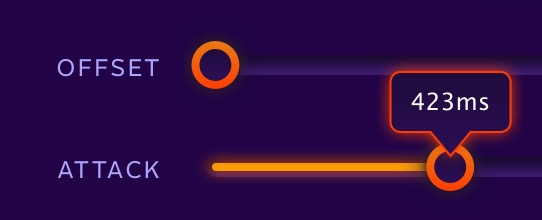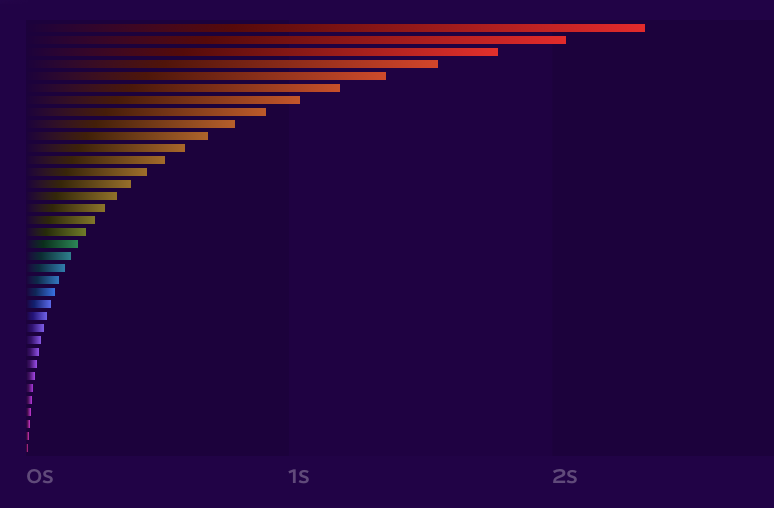It’s a bit overwhelming to have to adjust envelopes for individual harmonics one by one (although, we do let you do that in advanced mode, at least for the first 36).
Meta Parameters
Sine Machine’s envelopes controls let you edit the envelopes of all harmonics in bulk. They are “meta controls” that adjust values for all harmonics at once.

The first 36 harmonics have automatable parameters for the whole envelope. That means they’ll show up in the DAW individually too.
Envelope Segments
There are millions of different kinds of ADSR variants in the world. Sine Machine has some pretty unique behaviors resulting from the fact that up to 500 envelopes trigger with each on Note On.
OFFSET is the amount of time after you press a key that a harmonic silently waits before it moves to ATTACK.
ATTACK is the amount of time a harmonic takes to go from OFF to full volume (as set on the Volumes page) at which point it starts to decay. It is a logarithmic attack. If interrupted before reaching full volume it will move to DECAY.
DECAY is the amount of time taken for a harmonic to go from full volume to the level set by SUSTAIN. This is an exponential curve. If ATTACK didn’t reach full volume, it will decay from the last reached volume.
SUSTAIN is the default volume when holding down a note (after ATTACK and DECAY have completed, if times are set). Note that it is impacted by the harmonic volumes.
HOLD is the amount of time that the harmonic stays at the SUSTAIN volume after Note Off fires. If a harmonic didn’t yet reach SUSTAIN, it will hold at its last value.
RELEASE is the amount of time the harmonic takes to fall back to silence from SUSTAIN. This is an exponential curve.Note that this is a constant amount of time, regardless of what SUSTAIN is set to. If the harmonic didn’t reach the SUSTAIN level because its attack or decay was interrupted by Note Off, it will fade from its last value. The release times are quicker in that case, as the curve is calculated for the full sustain level-to-zero distance.
Harmonic envelopes are independent
Each harmonic’s envelope behaves totally independently from each other. That means, one component of a note might be still be in ATTACK while another component of the note is in RELEASE
This makes it very quickly create rich timbres that evolve over time.

ATTACK, DECAY, SUSTAIN and RELEASE all before the 20th harmonic even starts (due to high OFFSET)Actual note timing can vary
One thing you might notice is that played notes might sound longer or shorter than what the slider or visualization displays.
That’s because in additive synthesis, each note that you play up and down the keyboard will have a different number of harmonics. So, in the example pictured above (linear offset), a voice with only 10 harmonics will end much sooner than a voice with 100 harmonics.
Sine Machine’s envelope timings were first calibrated for middle C, but over time we found they are best calibrated for 36 harmonics (which matches the visualizer).
It would have been technically possible to do the opposite — guarantee the envelope timings are absolutely correct for every note played — but that would come with costs (every harmonic has a dynamic length, timbres change, linear rhythmic timings are no longer possible, etc).
Note that for some Low to High harmonic shapes, the envelopes will cheat a bit to keep the timings sane.

Fast Kill
When 20 voices are already playing and a new note is played, one of the older voices will be killed. There’s a hidden, special envelope segment responsible for killing that voice within a few ms (preventing clicks).
Special envelope cases
Because the envelopes control just a segment of a note’s overall sound, there’s some unique opportunities to do things not possible with other envelopes.
Leave a Reply